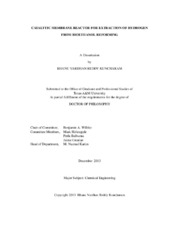| dc.description.abstract | This research explores a novel application of catalytic membrane reactors for high- purity hydrogen extraction from bioethanol reforming. Conventional membrane systems employ hydrogen permselective materials such as palladium, polymer membranes, which present several material challenges including embrittlement, thermal degradation and poisoning by hydrocarbons when used for high-temperature hydrocarbon reforming. Thus, the present work is motivated by an interest in employing reactor design concepts to alleviate our reliance upon permselective materials. Catalytic membrane reactor with segregated reactant(s) is employed to demonstrate the hypothesis that high-purity hydrogen with competitive hydrogen recoveries can be achieved by manipulating the reaction and diffusion phenomena, and corresponding thermal gradients inside the catalytic membrane, in the absence of any permselective materials. The hypothesis is demonstrated in two designs: (1) a single functional layer design for water-gas-shift catalytic membrane reactor, and (2) a multi-layer design for bioethanol reforming. A two-dimensional model is developed to describe reaction and diffusion in the catalytic membrane coupled with plug-flow equations in the retentate and permeate volumes using shell and tube architecture. Simulation results for a typical diesel reformate mixture (9 mol% CO, 3 mol% CO2, 28 mol% H2 and 15 mol% H2O) demonstrate that H2:CO permselectivities of 90:1 to > 200:1 with permeate hydrogen recoveries of 20% to 40% can be achieved through appropriate catalytic membrane design. This single reaction simulation results are used to establish a clear rubric of design rules that are then used as a base for designing catalytic membrane reactor for extraction of hydrogen from bioethanol (16 mol% ethanol). The two-dimensional catalytic membrane reactor for bioethanol reforming is simulated, using a network of ethanol reforming reactions and a composite
iicatalyst with unique catalytic layers active for one or more reactions. The isothermal simulation results show that an apparent H2:CO permselectivity of 100:1 with hydrogen recovery of 15% can be achieved at appropriate design and flow configuration. This model is extended to a non-isothermal design, which predicted a decrease in membrane performance owing to endothermic reforming reaction. An autothermal design with an additional combustion catalyst layer to counteract the endothermic thermal gradients enhanced the non-isothermal membrane performance. Experiments were conducted to validate the water-gas-shift catalytic membrane reactor model using a gas permeation system; results qualitatively agree with the modeling results and quantitively with an error. | en |


